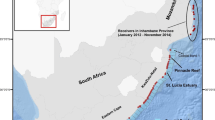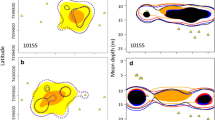Abstract
Variability is a hallmark of animal behavior and the degree of variability may fluctuate in response to environmental or biological gradients. For example, diel activity patterns during reproductive migrations often differ from those in non-breeding habitats, reflecting trade-offs among efficient route selection, reproductive phenology, and risk avoidance. In this study, we tested the hypothesis that diel movements of anadromous fishes differ among freshwater migration habitats. We analyzed diel movement data from ~13 000 radio-, PIT-, and acoustic-tagged adult fishes from five Columbia River species: Chinook salmon, Oncorhynchus tshawytscha; sockeye salmon, O. nerka; steelhead, O. mykiss; Pacific lamprey, Entosphenus tridentatus; and American shad, Alosa sapidissima. All five species were active during most of the diel cycle in low-gradient, less hydraulically complex reservoir and riverine habitats. Movement shifted to predominantly diurnal (salmonids and American shad) or nocturnal (Pacific lamprey) at hydroelectric dam fishways where hydraulic complexity and predator density were high. Results suggest that context-dependent behaviors are common during fish migrations, and that diel activity patterns vary with the degree of effort or predation risk required for movement.



Similar content being viewed by others
References
Aarestrup K, Økland F, Hansen MM, Righton D, Gargan P, Castonguay M (2009) Oceanic spawning migration of the European eel (Anguilla anguilla). Science 44:399–407
Balon EK (1975) Reproductive guilds of fishes: a proposal and definition. J Fish Res Board Can 32:821–864
Bernatchez L, Dodson JJ (1987) Relationship between bioenergetics and behavior in anadromous fish migrations. Can J Fish Aquat Sci 44:399–407
Binder TR, McDonald DG (2007) Is there a role for vision in the behaviour of sea lampreys (Petromyzon marinus) during their upstream spawning migration? Can J Fish Aquat Sci 64:1403–1412
Boujard T, Leatherland JF (1992) Circadian rhythms and feeding time in fishes. Environ Biol Fish 35:109–131
Brannon EL, Powell MS, Quinn TP, Talbot A (2004) Population structure of Columbia River basin Chinook salmon and steelhead trout. Rev Fish Sci 12:99–232
Brown RS, Geist DR, Mesa MG (2006) Use of electromyogram telemetry to assess swimming activity of adult spring Chinook salmon migrating past a Columbia River dam. Trans Am Fish Soc 135:281–287
Castro-Santos T, Letcher BH (2010) Modeling migratory energetics of Connecticut River American shad (Alosa sapidissima): implications for the conservation of an iteroparous anadromous fish. Can J Fish Aquat Sci 67:806–830
Caudill CC, Daigle WR, Keefer ML, Boggs CT, Jepson MA, Burke BJ, Zabel RW, Bjornn TC, Peery CA (2007) Slow dam passage in Columbia River salmonids associated with unsuccessful migration: delayed negative effects of passage obstacles or condition-dependent mortality? Can J Fish Aquat Sci 64:979–995
Dickerson BR, Brinck KW, Willson MF, Bentzen P, Quinn TP (2005) Relative importance of salmon body size and arrival time at breeding grounds to reproductive success. Ecology 86:347–352
Downing SL, Prentice EF (2004) Overview of the performance of PIT-tag interrogation systems for adult salmonids at Bonneville and McNary dams, 2002. Bonneville Power Admistration, Portland
Drent R, Both C, Green M, Madsen J, Piersma T (2003) Pay-offs and penalties of competing migratory schedules. Oikos 103:274–292
Einum S, Fleming IA (2000) Selection against late emergence and small offspring in Atlantic salmon (Salmo salar). Evolution 54:628–639
Finelli CM, Pentcheff ND, Zimmer-Faust RK, Wethey DS (1999) Odor transport in turbulent flows: constraints on animal navigation. Limnol Oceanogr 44:1056–1071
Flecker AS (1992) Fish predation and the evolution of invertebrate drift periodicity—evidence from neotropical streams. Ecology 73:438–448
Gilliam JF, Fraser DF (2001) Movement in corridors: enhancement by predation threat, disturbance, and habitat structure. Ecology 82:258–273
Goodman DH, Reid SB, Docker MF, Haas GR, Kinziger AP (2008) Mitochondrial DNA evidence for high levels of gene flow among populations of a widely distributed anadromous lamprey Entosphenus tridentatus (Petromyzontidae). J Fish Biol 72:400–417
Gowans ARD, Armstrong JD, Priede IG, Mckelvey S (2003) Movements of Atlantic salmon migrating upstream through a fish-pass complex in Scotland. Ecol Freshw Fish 12:177–189
Guttal V, Couzin ID (2010) Social interactions, information use, and the evolution of collective migration. Proc Natl Acad Sci U S A 107:16172–16177
Gwinner E (1996) Circadian and circannual programmes in avian migration. J Exp Biol 199:39–48
Haro A, Kynard B (1997) Video evaluation of passage efficiency of American shad and sea lamprey in a modified Ice Harbor fishway. N Am J Fish Manag 17:981–987
Hays GC (2003) A review of the adaptive significance and ecosystem consequences of zooplankton diel vertical migrations. Hydrobiologia 503:163–170
Helfman GS (1983) Fish behaviour by day, night and twilight. In: Pitcher TJ (ed) Behaviour of teleost fishes. Chapman and Hall, London, pp 497–512
Hendricks ML, Hoopes RL, Arnold DA, Kaufmann ML (2002) Homing of hatchery-reared American shad to the Lehigh River, a tributary to the Delaware River. N Am J Fish Manag 22:243–248
Hinch SG, Rand PS (1998) Swim speeds and energy use of upriver-migrating sockeye salmon (Oncorhynchus nerka): role of local environment and fish characteristics. Can J Fish Aquat Sci 55:1821–1831
Ims RA (1990) On the adaptive value of reproductive synchrony as a predator-swamping strategy. Am Nat 136:485–498
Kats LB, Dill LM (1998) The scent of death: chemosensory assessment of predation risk by prey animals. Ecoscience 5:361–394
Keefer ML, Peery CA, Daigle WR, Jepson MA, Lee SR, Boggs CT, Tolotti KR, Burke BJ (2005) Escapement, harvest, and unknown loss of radio-tagged adult salmonids in the Columbia River—Snake River hydrosystem. Can J Fish Aquat Sci 62:930–949
Keefer ML, Peery CA, Heinrich MJ (2008) Temperature-mediated en route migration mortality and travel rates of endangered Snake River sockeye salmon. Ecol Freshw Fish 17:136–145
Keefer ML, Moser ML, Boggs CT, Daigle WR, Peery CA (2009) Effects of body size and river environment on the upstream migration of adult Pacific lampreys. N Am J Fish Manag 29:1214–1224
Keefer ML, Peery CA, Lee SR, Daigle WR, Johnson EL, Moser ML (2011) Behavior of adult Pacific lampreys in near-field flow and fishway design experiments. Fish Manag Ecol 18:177–189
Klinka DR, Reimchen TE (2002) Nocturnal and diurnal foraging behaviour of brown bears (Ursus arctos) on a salmon stream in coastal British Columbia. Can J Zool 80:1317–1322
Kynard B, Buerkett C (1997) Passage and behavior of adult American shad in an experimental louver bypass system. N Am J Fish Manag 17:734–742
McIlraith B (2011) The adult migration, spatial distribution, and spawning behaviors of anadromous Pacific lamprey (Lampetra tridentata) in the lower Snake River. Master’s Thesis, Department of Fish and Wildlife Resources, University of Idaho, Moscow, Idaho, USA
Metcalfe NB, Fraser NHC, Burns MD (1998) State-dependent shifts between nocturnal and diurnal activity in salmons. Proc R Soc B Biol Sci 265:1503–1507
Metcalfe NB, Fraser NHC, Burns MD (1999) Food availability and the nocturnal vs. diurnal foraging trade-off in juvenile salmon. J Anim Ecol 68:371–381
Moser ML, Ocker PA, Stuehrenberg LC, Bjornn TC (2002) Passage efficiency of adult Pacific lampreys at hydropower dams on the lower Columbia River, USA. Trans Am Fish Soc 131:956–965
Naughton GP, Caudill CC, Keefer ML, Bjornn TC, Stuehrenberg LC, Peery CA (2005) Late-season mortality during migration of radio-tagged sockeye salmon (Oncorhynchus nerka) in the Columbia River. Can J Fish Aquat Sci 62:30–47
Neill SRJ, Cullen JM (1974) Experiments on whether schooling by their prey affects the hunting behavior of cephalopods and fish predators. J Zool 172:549–569
Parsley MJ, Wright CD, van der Leeuw BK, Kofoot EE, Peery CA, Moser ML (2007) White sturgeon (Acipenser transmontanus) passage at The Dalles Dam, Columbia River, USA. J Appl Ichthyol 23:627–635
Railsback SF, Harvey BC, Hayse JW, LaGory KE (2005) Tests of theory for diel variation in salmonid feeding activity and habitat use. Ecology 86:947–959
Reebs SG (2002) Plasticity of diel and circadian activity rhythms in fishes. Rev Fish Biol Fish 12:349–371
Reinhardt UG, Eidietis L, Friedl SE, Moser ML (2008) Pacific lamprey climbing behavior. Can J Zool 86:1264–1272
Smith IP, Smith GW (1997) Tidal and diel timing of river entry by adult Atlantic salmon returning to the Aberdeenshire Dee, Scotland. J Fish Biol 50:463–474
Standen EM, Hinch SG, Healey MC, Farrell AP (2002) Energetic costs of migration through the Fraser River Canyon, British Columbia, in adult pin (Oncorhynchus gorbuscha) and sockeye (Oncorhynchus nerka) salmon as assessed by EMG telemetry. Can J Fish Aquat Sci 59:1809–1818
Stansell RJ, Gibbons KK, Nagy WT (2010) Evaluation of pinniped predation on adult salmonids and other fish in the Bonneville Dam tailrace, 2008–2010. U.S. Army Corps of Engineers, Fisheries Field Unit, Portland
Torney C, Neufeld Z, Couzin ID (2009) Context-dependent interaction leads to emergent search behavior in social aggregates. Proc R Soc B Biol Sci 106:22055–22060
Vickers NJ (2000) Mechanisms of animal navigation in odor plumes. Biol Bull 198:203–212
Vrieze LA, Bjerselius R, Sorenson PW (2010) Importance of the olfactory sense to migratory sea lampreys Petromyzon marinus seeking riverine spawning habitat. J Fish Biol 76:949–964
Vrieze LA, Bergstedt RA, Sorenson PW (2011) Olfactory-mediated stream-finding behavior of migratory adult sea lamprey (Petromyzon marinus). Can J Fish Aquat Sci 68:523–533
Waples RS, Zabel RW, Scheuerell MD, Sanderson BL (2007) Evolutionary responses by native species to major anthropogenic changes to their ecosystems: Pacific salmon in the Columbia River hydropower system. Mol Ecol 17:84–96
Wright BE, Riemer SD, Brown RF, Ougzin AM, Bucklin KA (2007) Assessment of harbor seal predation on adult salmonids in a Pacific northwest estuary. Ecol Appl 17:338–351
Acknowledgments
Many people provided time and assistance during the course of the monitoring studies. We thank: T. Bjornn, T. Clabough, C. Boggs, T. Dick, M. Heinrich, B. Ho, E. Johnson, M. Jepson, D. Joosten, S. Lee, B. McIlraith, M. Morasch, G. Naughton, D. Queampts, R. Ringe, K. Tolotti, W. Daigle, and M. Quist (University of Idaho); B. Burke, K. Frick, and L. Stuehrenberg (National Marine Fisheries Service); H. Pennington (Pacific States Marine Fisheries Commission); D. Clugston, M. Langeslay, T. Mackey, J. Rerecich, M. Shutters, and S. Tackley (U.S. Army Corps of Engineers); and J. Beeman, T. Castro-Santos and S. Juhnke (U.S. Geological Society).
Author information
Authors and Affiliations
Corresponding author
Rights and permissions
About this article
Cite this article
Keefer, M.L., Caudill, C.C., Peery, C.A. et al. Context-dependent diel behavior of upstream-migrating anadromous fishes. Environ Biol Fish 96, 691–700 (2013). https://doi.org/10.1007/s10641-012-0059-5
Received:
Accepted:
Published:
Issue Date:
DOI: https://doi.org/10.1007/s10641-012-0059-5




